Rice bran stays fresh thanks to its rich antioxidants, like γ-oryzanol and phenolic compounds. These protect against oxidation, which leads to spoilage. By preventing the breakdown of fats and preserving nutrients, antioxidants help maintain the bran's flavor and health benefits. This means you'll enjoy rice bran for longer without it turning rancid. Additionally, proper storage in cool, dark places can enhance its freshness even further. If you're curious about how antioxidants work or want tips on using rice bran in your kitchen, there's more to explore.
Antioxidant Composition of Rice Bran
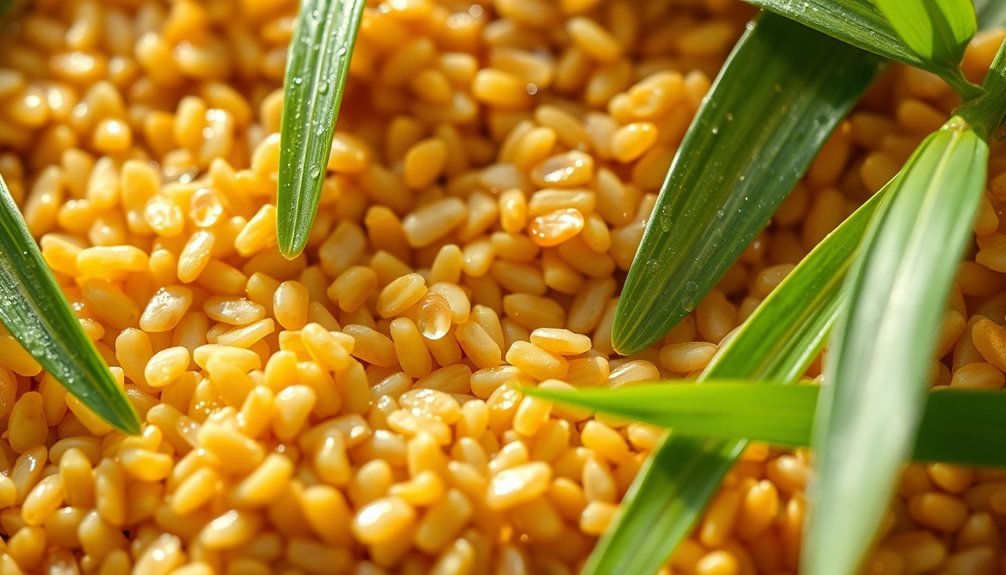
When it comes to the antioxidant composition of rice bran, several key components stand out for their health benefits. One of the most important is γ-oryzanol, which makes up 39-63% of the antioxidant content in rice bran. This compound not only inhibits lipid peroxidation but also stabilizes rice bran oil, making it essential for maintaining freshness. Additionally, studies have shown that phenolic compounds from rice bran exhibit significant antioxidant and anti-inflammatory properties, enhancing the overall health benefits of this nutrient-rich by-product.
You'll also find a range of phenolic acids, with ferulic acid being the most dominant. These acids contribute to the overall antioxidant properties of rice bran, varying considerably between different types, such as black and red rice bran.
In black rice bran, anthocyanins like cyanidin-3-glucoside play a vital role, comprising 58-95% of its anthocyanin content.
Tocopherols, particularly α-tocopherol and γ-tocopherol, offer protection to cell membranes and enhance stability by trapping lipid peroxyl radicals. Additionally, flavonoids and phytic acid contribute to rice bran's antioxidant capacity, especially in pigmented varieties.
Benefits of Antioxidants in Preservation
Antioxidants play an essential role in preserving food quality by actively preventing oxidation and rancidity. By inhibiting oxidation processes, they delay the deterioration of foods, particularly fats and oils, ensuring that their taste and odor remain intact. When you consume rice bran oil, for instance, antioxidants like gamma-oryzanol work effectively to maintain its freshness while neutralizing harmful free radicals.
Moreover, antioxidants protect important nutrients from being destroyed by air exposure. They safeguard vitamins and amino acids, preserving the food's nutritional value for a longer period. This is significant for reaping the health benefits associated with your meals, as natural occurring antioxidants help prevent browning and loss of quality in various food products.
Antioxidants also extend the shelf-life of your food products, reducing spoilage and maintaining freshness. This not only benefits you as a consumer but also aids producers and distributors by minimizing economic losses due to waste. Freshness and quality are preserved over time, enhancing your overall experience.
Additionally, antioxidants maintain the sensory properties of foods, preventing discoloration and undesirable flavors. By ensuring that taste, texture, and appearance remain appealing, antioxidants play a critical role in consumer satisfaction and product preference.
Fermentation Techniques for Enhanced Antioxidants
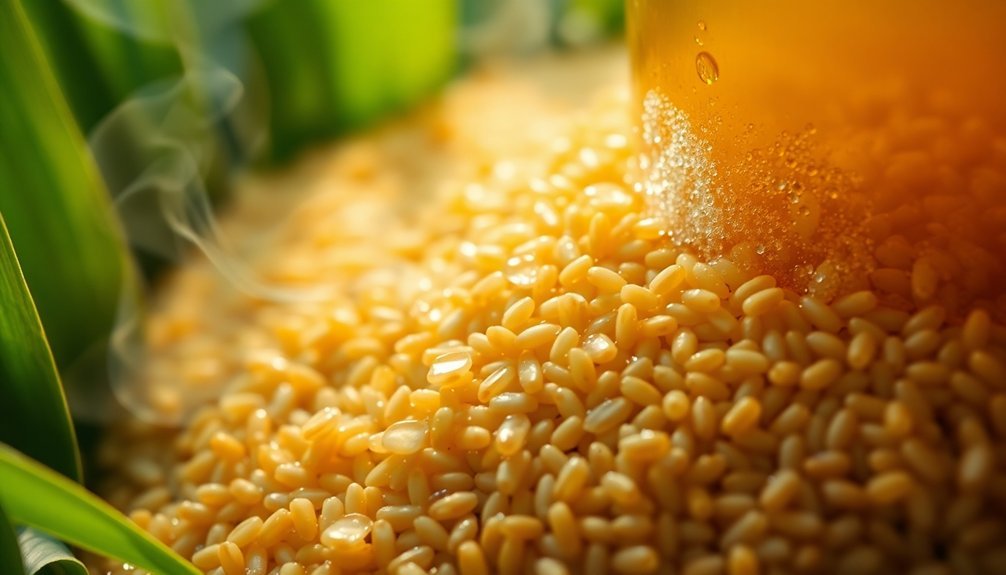
Fermentation techniques offer a powerful method to enhance the antioxidant properties of rice bran. By employing solid-state fermentation (SSF) with microorganisms like molds and lactic acid bacteria, you can greatly boost the levels of bioactive compounds. For instance, using Rhizopus oryzae can increase total phenolic compounds (TPC) by up to five times, while also improving the sensory profile, making rice bran more palatable. Additionally, mixed-bacteria fermentation significantly enhances antioxidant activities, leading to improved health benefits.
Here's a quick overview of fermentation techniques and their benefits:
| Technique | Benefits |
|---|---|
| Solid-State Fermentation (SSF) | Increases TPC and enhances flavor |
| Mixed-Bacteria Fermentation | Boosts antioxidant activity and protein content |
| Lactic Acid Bacteria Fermentation | Raises levels of ferulic acid and γ-oryzanol |
| Enzymatic Activity | Breaks down cell walls, releasing phenolics |
| Sensory Profile Improvement | Offers better aroma and taste |
These techniques not only enhance antioxidant activity but also change the phenolic acid composition, making fermented rice bran a more nutritious option. By incorporating these fermentation methods, you can reveal the full potential of rice bran's health benefits.
Effective Extraction Methods
Effective extraction methods are essential for maximizing the antioxidant potential of rice bran. Supercritical CO2 extraction stands out, yielding between 14.76% and 18.16% of rice bran oil (RBO) while maintaining the best physicochemical properties, especially from black rice. This method preserves delicate phytochemicals at lower temperatures and pressures, resulting in higher antioxidant activity compared to cold-press and solvent extraction.
Solvent extraction is another effective method, with yields ranging from 17.35% to 20.19%. It excels in extracting γ-oryzanol and tocols, showcasing superior antioxidant properties. Higher trolox equivalent antioxidant capacity (TEAC) values in ABTS assays indicate its efficiency.
Ultrasonic extraction using a 50:50 ethanol-water mixture reveals the highest antioxidant activity, enhancing phenolic compounds and tocotrienols. Its lower IC50 values in DPPH assays signal its effectiveness compared to traditional methods like maceration.
Cold-press extraction, while yielding only 3.22% to 6.22% of RBO, preserves the natural flavor and nutrients. However, it's less efficient for extracting γ-oryzanol.
Each method has its strengths, and choosing the right one can greatly impact the antioxidant content of rice bran oil.
Antioxidant Mechanisms Explained
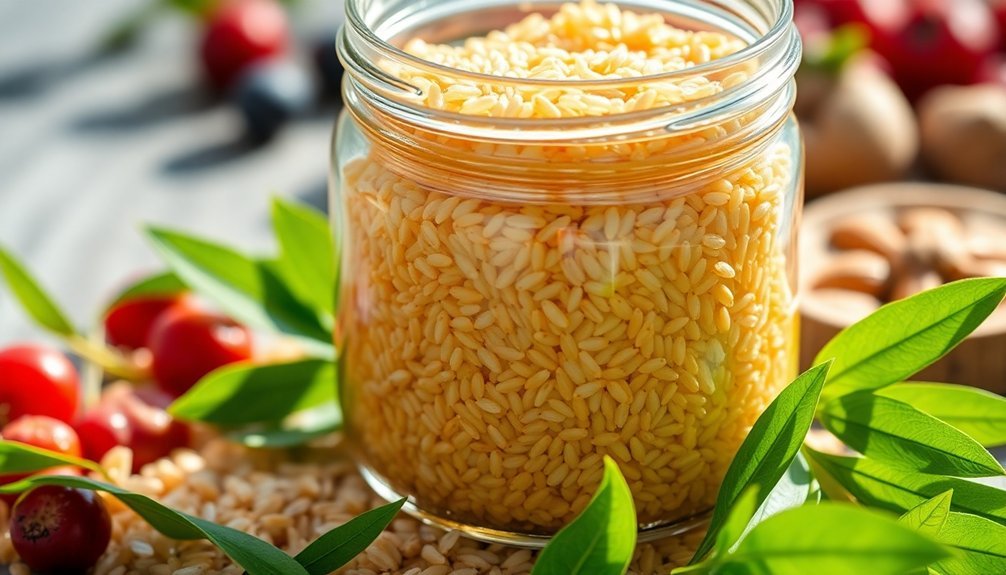
Understanding how antioxidants work can be fascinating, especially when you consider their vital role in neutralizing free radicals. Antioxidants do this primarily by donating electrons, which stabilizes free radicals and prevents them from causing cellular damage.
For instance, compounds like tocopherols and γ-oryzanol found in rice bran trap lipid peroxyl radicals, effectively inhibiting lipid peroxidation.
Additionally, antioxidants can donate hydrogen to neutralize lipid radicals, protecting cell membranes. They also bind with metal ions that are essential for free radical production, thereby halting the creation of new radicals.
Beyond these protective actions, antioxidants initiate repair processes for any oxidative damage already inflicted.
Specific antioxidants in rice bran play unique roles. Tocopherols shield cell membranes and enhance stability, while γ-oryzanol boasts high antioxidant power.
Phytosterols stabilize rice bran oil, and flavonoids like quercetin contribute notably to antioxidant activity due to their chemical structure.
Health Benefits of Rice Bran Antioxidants
Rice bran antioxidants can play an essential role in regulating cholesterol levels, helping you maintain a healthier heart.
They also show promise in inhibiting cancer growth, providing a protective effect against various types of cancer cells.
Cholesterol Level Regulation
While many factors influence cholesterol levels, incorporating rice bran antioxidants into your diet can greatly enhance your heart health.
Rice bran oil has been shown to reduce LDL (bad) cholesterol by an average of 6.91 mg/dL across multiple studies. When compared to soybean oil, the decrease in LDL cholesterol can range from 8% to 12.2%. Not only that, but rice bran oil also boosts HDL (good) cholesterol, with some studies reporting increases of up to 41%.
This cholesterol-lowering effect is largely due to plant sterols in rice bran oil, which help prevent cholesterol absorption. Additionally, gamma-oryzanol found in rice bran enhances the oil's ability to lower cholesterol by improving solubility in cell membranes.
It also exhibits antioxidant properties, surpassing vitamin E in inhibiting cholesterol oxidation. Including just two tablespoons of rice bran oil daily can markedly decrease LDL cholesterol and other heart disease risk factors, making it an excellent choice for anyone looking to improve their lipid profile.
With its ability to lower total cholesterol by 14% while raising HDL by 41%, rice bran truly offers a heart-healthy addition to your diet.
Cancer Growth Inhibition
Antioxidants found in rice bran have shown promising potential in the fight against cancer. Compounds like gamma-tocotrienol and gamma-oryzanol actively inhibit the growth of various cancer cells, including those from the breast, prostate, and colon. These antioxidants work by arresting the cancer cell cycle at critical phases, effectively halting their proliferation.
Additionally, rice bran contains phytic acid, which further prevents cancer cell growth in several types, while tricin specifically targets breast and prostate cancer cells at the G2/M phase. This powerful blend of compounds modulates apoptosis, enhancing the effectiveness of traditional chemotherapy drugs.
Research indicates that rice bran extracts not only reduce tumor growth but also activate your immune system, boosting the activity of natural killer cells and macrophages. This dual approach—combining direct cancer cell inhibition with immune support—makes rice bran a valuable ally in cancer prevention strategies.
Studies in animal models show that rice bran can considerably reduce tumor size, suggesting its potential as a chemopreventive agent across various cancers. Incorporating rice bran into your diet could be a proactive step toward cancer growth inhibition.
Practical Uses in Food Products
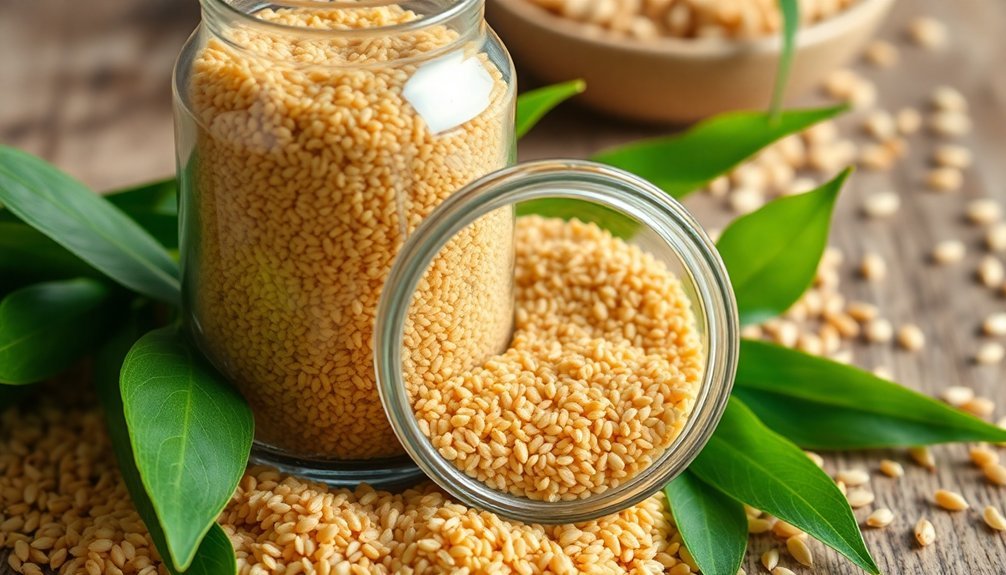
In cooking and preparing foods, rice bran oil stands out for its versatility and health benefits. Its high smoke point of 490-500 degrees makes it perfect for deep-frying, while its light, clean flavor complements various dishes without overpowering them. You'll find it ideal for grilling, sautéing, stir-frying, and baking, as well as in salad dressings, where it adds a slightly buttery and nutty taste.
Here's a quick overview of its practical uses:
| Cooking Method | Benefits |
|---|---|
| Deep-Frying | High smoke point; reusable |
| Sautéing/Stir-Frying | Retains nutrients; enhances flavor |
| Baking | Improves nutritional value in goods |
In restaurant settings, rice bran oil performs exceptionally well over high-energy burners. It's also a fantastic option for enhancing the nutritional value of pasta and baked goods. Incorporating rice bran dietary fiber can improve texture while contributing essential nutrients like vitamin E and plant sterols. Overall, using rice bran oil in your kitchen not only elevates your cooking but also supports a healthier lifestyle.
Impact on Shelf Life and Quality
Maintaining the freshness and quality of rice bran is vital for maximizing its nutritional benefits. The presence of natural antioxidants like oryzanol and tocotrienols helps reduce oxidation and rancidity, ensuring that the bran retains its nutritional value.
Adding antioxidants such as vitamin E and rosemary extract can further enhance preservation, inhibiting the oxidation of oils in the bran.
Storing rice bran in a cool, dark place greatly extends its shelf life. By minimizing exposure to light and maintaining a cool environment, you can slow down oxidation processes and keep the antioxidants intact.
Monitor humidity to prevent mold growth, and consider using desiccants if necessary.
Refrigeration is another effective method. It can prolong the freshness of rice bran for several months, particularly for opened rice bran oil, extending its shelf life to 9-12 months.
Regularly inspecting for spoilage is vital, even when refrigerated, and proper sealing in airtight containers is essential.
While stabilized rice bran can last up to a year, natural antioxidants provide health benefits that synthetic options may not.
Combining these methods will help you enjoy quality rice bran for an extended period.
Frequently Asked Questions
Can Rice Bran Antioxidants Affect Flavor in Food Products?
Yes, rice bran antioxidants can affect flavor in food products. They help maintain freshness without altering taste considerably, allowing you to incorporate rice bran into various dishes while preserving the original flavor profile of your recipes.
How Do Antioxidants in Rice Bran Compare to Other Sources?
When you compare antioxidants in rice bran to other sources, you'll find rice bran has higher levels of γ-oryzanol and vitamin E, offering superior protection against oxidation and enhancing nutritional value in food products.
What Factors Influence the Stability of Antioxidants in Rice Bran?
Factors influencing the stability of antioxidants in rice bran include processing methods, storage temperature, moisture content, and packaging. You'll want to optimize these conditions to maintain the beneficial properties of antioxidants effectively.
Are There Specific Storage Conditions to Maintain Rice Bran Freshness?
To maintain rice bran's freshness, store it in a cool, dry place between 50°F and 70°F. Use airtight containers to prevent moisture and pests, and consider refrigeration or freezing for extended shelf life.
How Can Consumers Incorporate Rice Bran Into Their Daily Diet?
You can easily incorporate rice bran into your daily diet by adding it to smoothies, baked goods, cereals, or energy bars. Using rice bran oil for cooking or salad dressings boosts nutrition and flavor effortlessly.
In Summary
In summary, the antioxidants in rice bran play an essential role in keeping it fresh and extending its shelf life. By understanding their composition and mechanisms, you can appreciate how these compounds not only preserve quality but also offer health benefits. Whether you're using rice bran in your cooking or considering it for food products, its antioxidant-rich profile makes it a valuable addition to your pantry. Embrace rice bran for both its nutritional advantages and its longevity!

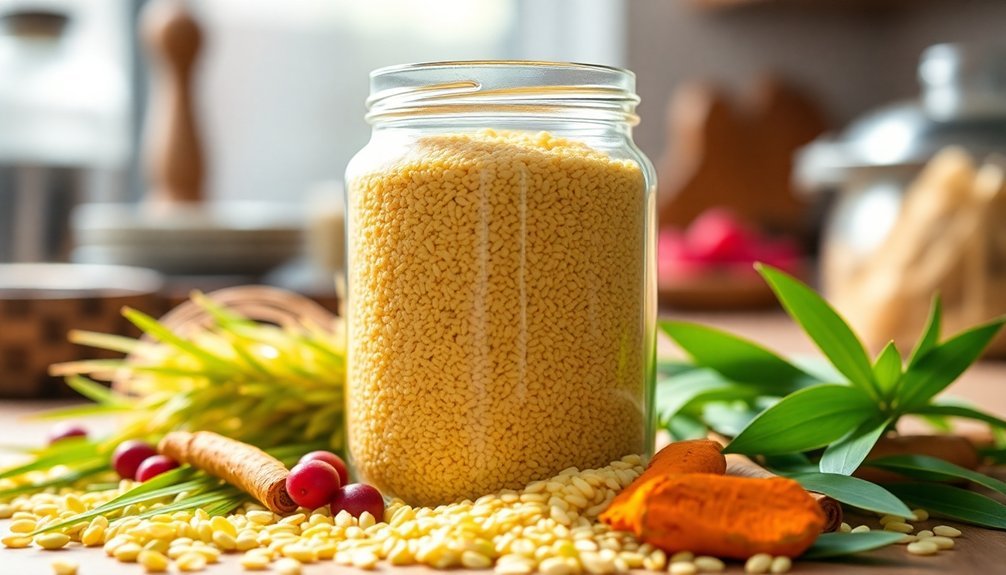

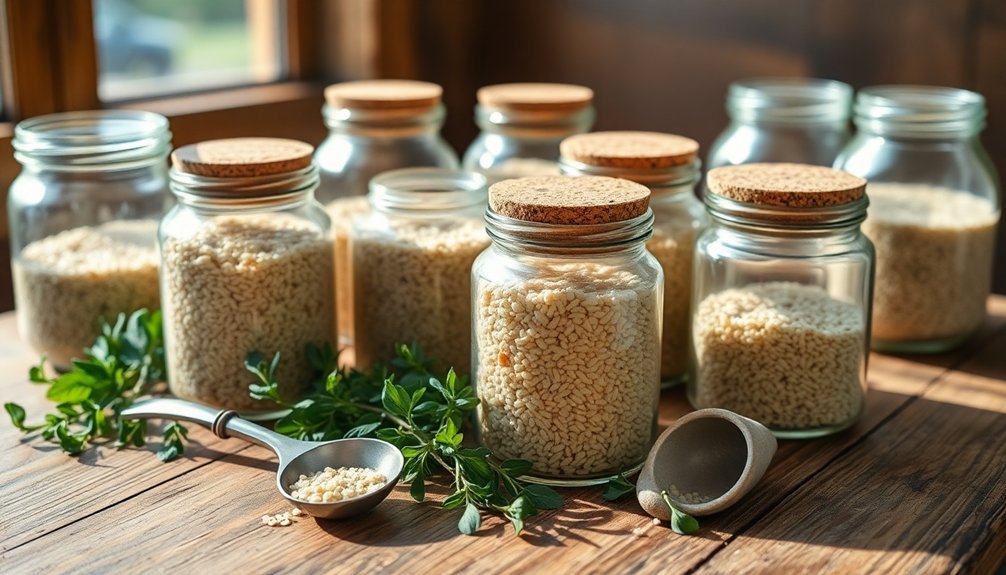

Leave a Reply